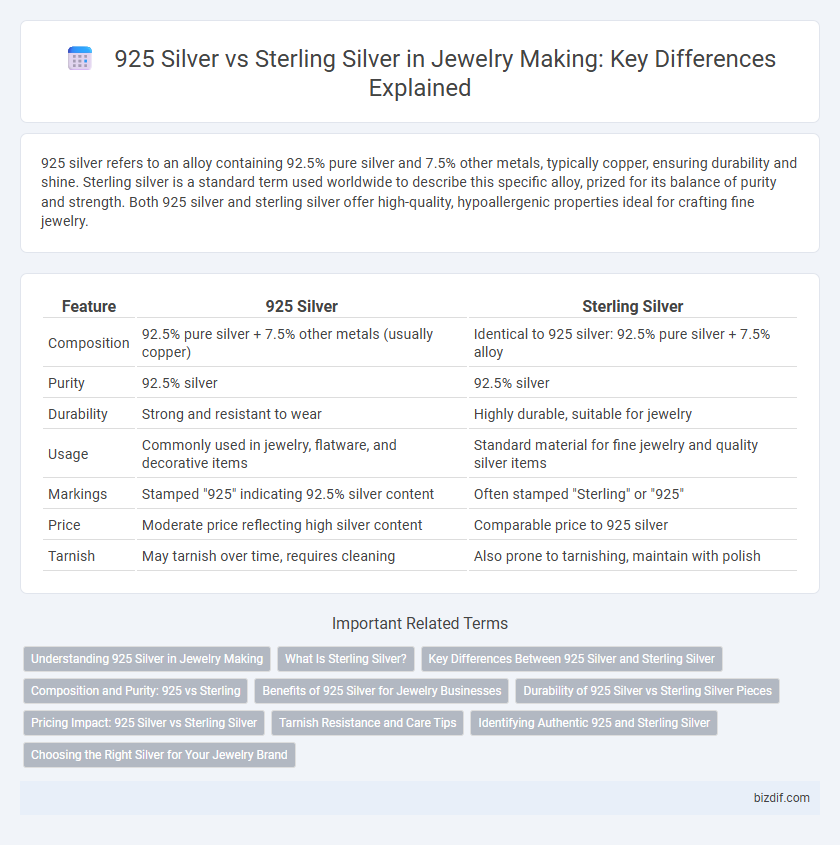925 silver refers to an alloy containing 92.5% pure silver and 7.5% other metals, typically copper, ensuring durability and shine. Sterling silver is a standard term used worldwide to describe this specific alloy, prized for its balance of purity and strength. Both 925 silver and sterling silver offer high-quality, hypoallergenic properties ideal for crafting fine jewelry.
Table of Comparison
| Feature | 925 Silver | Sterling Silver |
|---|---|---|
| Composition | 92.5% pure silver + 7.5% other metals (usually copper) | Identical to 925 silver: 92.5% pure silver + 7.5% alloy |
| Purity | 92.5% silver | 92.5% silver |
| Durability | Strong and resistant to wear | Highly durable, suitable for jewelry |
| Usage | Commonly used in jewelry, flatware, and decorative items | Standard material for fine jewelry and quality silver items |
| Markings | Stamped "925" indicating 92.5% silver content | Often stamped "Sterling" or "925" |
| Price | Moderate price reflecting high silver content | Comparable price to 925 silver |
| Tarnish | May tarnish over time, requires cleaning | Also prone to tarnishing, maintain with polish |
Understanding 925 Silver in Jewelry Making
925 silver refers to an alloy containing 92.5% pure silver and 7.5% other metals, typically copper, to enhance durability without compromising the metal's natural luster. Sterling silver is synonymous with 925 silver, widely recognized in jewelry making for its balance of beauty, strength, and affordability. Understanding 925 silver is essential for jewelers aiming to create high-quality pieces that maintain shine while resisting tarnish and wear.
What Is Sterling Silver?
Sterling silver is an alloy composed of 92.5% pure silver and 7.5% other metals, usually copper, designed to enhance durability while maintaining silver's lustrous appearance. The term "925 silver" specifically refers to the percentage of pure silver content in sterling silver, making them effectively the same in composition. This alloy is widely used in jewelry making for its balance of beauty, strength, and affordability.
Key Differences Between 925 Silver and Sterling Silver
925 silver and sterling silver both refer to the same alloy composed of 92.5% pure silver and 7.5% other metals, primarily copper, to enhance durability. The term "925 silver" emphasizes the purity level, while "sterling silver" is the traditional name used in jewelry making to denote this standard. Key differences lie mainly in terminology and marketing rather than composition, as both ensure high-quality, tarnish-resistant, and lasting silver jewelry.
Composition and Purity: 925 vs Sterling
925 silver and Sterling silver both refer to the same alloy consisting of 92.5% pure silver and 7.5% other metals, primarily copper, to enhance durability and strength. The term "925 silver" highlights the purity level, indicating that 925 parts per thousand are pure silver, while "Sterling silver" is a traditional name used in the jewelry industry to denote this standard. This composition ensures high-quality jewelry with sufficient hardness to withstand daily wear while maintaining the luster and hypoallergenic properties of silver.
Benefits of 925 Silver for Jewelry Businesses
925 silver, also known as sterling silver, contains 92.5% pure silver and 7.5% other metals, offering a perfect balance of durability and shine essential for jewelry crafting. Its high purity ensures hypoallergenic properties, appealing to customers with sensitive skin and expanding market reach. The metal's affordability compared to higher purity silver allows businesses to produce elegant, long-lasting pieces while maintaining competitive pricing.
Durability of 925 Silver vs Sterling Silver Pieces
925 silver and sterling silver both refer to the same alloy containing 92.5% pure silver and 7.5% other metals, usually copper, ensuring similar durability. Sterling silver's composition is standardized for jewelry, providing strength and resistance to wear while maintaining a polished finish. Proper care and maintenance can enhance the longevity of both 925 silver and sterling silver pieces, making them ideal for everyday use.
Pricing Impact: 925 Silver vs Sterling Silver
925 silver and sterling silver are often used interchangeably, both containing 92.5% pure silver and 7.5% alloy, primarily copper, ensuring durability and quality. Pricing impact between 925 silver and sterling silver is minimal since their silver content is identical, making market value and craftsmanship more significant factors in cost differences. Consumers should focus on design complexity and brand reputation rather than expecting price variance solely based on the 925 or sterling silver label.
Tarnish Resistance and Care Tips
925 silver, composed of 92.5% pure silver and 7.5% other metals, commonly copper, offers moderate tarnish resistance compared to sterling silver, which is often used interchangeably but denotes the same 92.5% purity standard. Tarnish occurs when copper reacts with sulfur compounds in the air, so regular cleaning with a soft cloth and proper storage in anti-tarnish bags or cloths is essential to maintain the jewelry's shine. Avoid exposure to harsh chemicals, moisture, and prolonged air contact to enhance the lifespan and appearance of both 925 and sterling silver pieces.
Identifying Authentic 925 and Sterling Silver
925 silver and Sterling silver both refer to high-quality silver alloys containing 92.5% pure silver and 7.5% other metals, usually copper, for enhanced durability. Authentic 925 or Sterling silver jewelry often carries stamps such as "925," "Sterling," or "Ster" that certify its silver content. To verify authenticity, look for consistent hallmarking, conduct magnet tests (real silver is non-magnetic), and perform a nitric acid test for genuine silver composition.
Choosing the Right Silver for Your Jewelry Brand
925 silver and sterling silver both contain 92.5% pure silver, making them synonymous in jewelry making, with the remaining 7.5% typically composed of copper to enhance durability. Choosing between the two terms depends on marketing preferences, but emphasizing sterling silver highlights quality assurance and traditional craftsmanship. For a jewelry brand, focusing on the metal's composition, hypoallergenic properties, and tarnish resistance will attract discerning customers seeking lasting value.
925 silver vs Sterling silver Infographic

 bizdif.com
bizdif.com